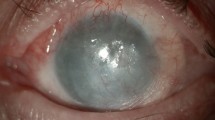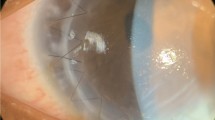Abstract
• Background: It was the purpose of this study to compile the results of all high-risk keratoplasties (kp) performed in our hospital under systemic ciclosporin A (Ci A) cover from 1987 through 1994. • Methods: One hundred and thirty-one keratoplasties were performed. Ci A was administered for an average period of 9.4 months. We aimed at trough levels of 100–150 ng/ml (monoclonal RIA/TDx). The 29 kp in group A were second or third repeat kp and/or the recipient cornea had severe deep vascularization in all quadrants and/or a transplant position at the limbus was inevitable (expected risk: only immune reactions). The 40 kp in group B were threatened by severe ocular surface disorders (without severe limbal stem cell insufficiency) and by immune reactions (atopic keratopathy, keratoconus with severe endogenous eczema or chronic blepharokeratoconjunctivitis). In the 45 kp of group C resurfacing problems from severe limbal stem cell insufficiency and immune reactions were anticipated (severe burns, pseudopemphigoid or Lyell syndrome). Group D comprised 17 kp with various diagnoses (e.g. kp in newborns, rheumatic andAcanthamoeba keratitis). • Results: In group A 91% of the grafts were clear 2 years postoperatively, in group B 76%, in group C 38% and in group D 18%. In 32 of 41 failed grafts (78%), resurfacing problems were the only reason for or participated in final graft failure. Immune reactions and other causes of graft failure were of minor importance. • Conclusions: (1) Systemic Ci A cover can efficiently suppress immune reactions. (2) With the suppression of immune reactions, resurfacing disorders become the most important single cause for functional graft failure. (3) For eyes with a considerable loss of limbal stem cells, limbal stem cell transplantation should be combined with systemic Ci A cover in order to improve the long-term prognosis for penetrating keratoplasty.
Similar content being viewed by others
References
Baggesen K, Ehlers N, Lamm LU (1991) HLA-DR/RFLP compatible corneal grafts. Acta Ophthalmol 69:229–233
BenEzra D, Maftzir G, Courten C de, Timonen P (1990) Ocular penetration of cyclosporin A. III. The human eye. Brit J Ophthalmol 74:350–352
Boisjoly HM, Roy R, Bernard PM, Dubé I, Laughrea PA, Bazin R (1990) Association between corneal allograft reactions and HLA compatibility. Ophthalmology 97:1689–1698
Chen YF, Gebhardt BM, Reidy JJ, Kaufman HE (1990) Cyclosporine-containing collagen shields suppress corneal allograft rejection. Am J Ophthalmol 109:132–137
Chen JY, Tseng SCG (1990) Corneal epithelial wound healing in partial limbal deficiency. Invest Ophthalmol Vis Sci 31:1301–1314
Collaborative Corneal Transplantation Studies CCTS (1992) Effectiveness of histocompatibility matching in highrisk corneal transplantation. Arch Ophthalmol 110:1392–1403
Coupland SE, Klebe S, Karow AC, Krause L, Bartlett RR, Hoffman F (1994) Leflunomide (HWA-486) in the allogenic rat penetrating keratoplasty model. Invest Ophthalmol Vis Sci 35:1878
Ehlers N, Andersen J (1987) Treatment of central corneal ulcers by à chaud transplantation of organ culture preserved donor tissue. Acta Ophthalmol 65:516–520
Ehlers N, Kissmeyer-Nielsen F (1979) Corneal transplantation and HLA histocompatibility. Acta Ophthalmol 57:738–741
Foulks GN, Sanfilippo FP, Locasio JA, MacQueen JM, Dawson D (1983) Histocompatibility testing for keratoplasty in high-risk patients. Ophthalmology 90:239–244
Gnad HD, Skorpik C, Radda TM, Paroussis P, Menapace R, Klemen UM (1985) Immunsuppressive Therapie mit Cyclosporin A nach perforierender Keratoplastik. Klin Monatsbl Augenheilkd 187:398–399
Heering P, Kutkuhn B, Kreuzpaitner G, Reinhard T, Sundmacher R, Grabensee B (1991) Untersuchungen zur Nierenfunktion nierengesunder Patienten unter Ciclosporin. Klin Wochenschr 69:880–886
Herbort CP, Matsubara M, Nishi M, Mochizuki M (1989) Penetrating keratoplasty in the rat: a model for the study of immunosuppressive treatment of graft rejection. Jpn J Ophthalmol 33:212–220
Hill JC (1989) The use of cyclosporine in high-risk keratoplasty. Am J Ophthalmol 107:506–510
Hill JC (1994) Systemic cyclosporine in high-risk keratoplasty. Short- versus long-term therapy. Ophthalmology 101:128–133
Hoffmann F, Pahlitzsch T (1989) Predisposing factors in corneal graft rejection. Cornea 8:215–219
Hoffmann F, Tregel M, Noske W, Bünte S (1994) HLA-A and -DR match reduces the allograft rejection after keratoplasty. Ger J Ophthalmol 3:100–104
Holland EJ, Olsen TW, Ketcham JM, Florine C, Krachmer JH, Purcell JJ, Lam S, Tessler H, Sugar J (1993) Topical cyclosporin A in the treatment of anterior segment inflammatory disease. Cornea 12:413–419
Hoppeler T, Balogh T, Kalman, Gloor B (1993) Autologe Limbustransplantation nach Verätzung. In: Gloor B, Hartmann C, Rochels R (eds) Kongreßband DGII. Springer, Berlin Heidelberg New York, pp 429–433
Huang AJW, Tseng SCG (1991) Corneal epithelial wound healing in the absence of limbal epithelium. Invest Ophthalmol Vis Sci 32:96–105
Irschick EU, Siepe U, Pöttinger E, Daxer A, Ulmer H, Falk M, Göttinger W (1994) Eight years follow-up of high-risk corneal allograft recipients under a three months course of Cyclosporin A. Invest Ophthalmol Vis Sci 35 (4):1876
Kahan BD (1989) Cyclosporine. New Engl J Med 321:1725–1738
Kenyon KR, Tseng SCG (1989) Limbal autograft transplantation for ocular surface disorders. Ophthalmology 96:709–723
Kervick GN, Shepherd WF (1990) The pattern of corneal graft rejection. Cornea 9:234–237
Kruse HA, Bechrakis NE, Heimann H, Diamantstein T, Hoffmann F (1991) Specific immunosuppressive therapy by monoclonal antibodies on rejection of orthoptic corneal allogenic grafts in the rat. Invest Ophthalmol Vis Sci 32:1119
Land W (1987) Optimal use of Sandimmun in organ transplantation. Springer, Berlin Heidelberg New York, pp 7–24
Maguire MG, Fink NE, Sugar A, Stark WJ, Stulting RD, CCTS (1993) Risk factors for corneal graft failure in high risk patients in the Collaborative Corneal Transplantation Studies. Invest Ophthalmol Vis Sci 34:1098
Milani JK, Pleyer U, Dukes A, Chou HJ, Lutz S, Rückert D, Schmidt K-H, Mondino BJ (1993) Prolongation of corneal allograft survival with liposome-encapsulated Cyclosporine in the rat eye. Ophthalmology 100:890–896
Miller K, Kieselbach GF, Niederwieser D, Huber C, Margreiter R, Göttinger W (1985) Immunsuppression mit Cyclosporin A bei Risikokeratoplastiken. Klin Monatsbi Augenheilkd 187:394–397
Mytilineos J, Scherer S, Opeltz G (1990) Comparison of RFLP DR beta and serological HLA-DR typing in 1500 individuals. Transplantation 50:870–873
Pels E, Gaag R van der (1984) HLA-A, B, C and HLA-DR antigens and dendritic cells in fresh and organ culture preserved corneas. Cornea 3:231–239
Redbrake C, Tympnert J, Reim M (1993) Komplikationen nach Keratoplastik. Ophthalmologe 90 [Suppl 1]:47
Rehany U (1992) Suppression of allograft rejection in heavily vascularized human corneas. Second International Symposium on Ocular Inflammation, Jerusalem, 30 August–3 September 1992
Riisom K, Ehlers N, Lamm L (1987) Post mortem HLA-DR typing of donor corneas using DNA hybridization technique. Acta Ophthalmol 65:430–432
Rossa V, Sundmacher R, Heering P (1990) Systemische Cyclosporin A Prophylaxe bei Risiko-Keratoplastiken. Klin Monatsbl Augenheilkd 197:466–469
Stark WJ, Taylor HR, Blas WB, Maumenee AE (1978) Histocompatibility (HLA) antigens and keratoplasty. Am J Ophthalmol 86:595–604
Sundmacher R (1977) Immunreaktionen nach Keratoplastik. Klin Monatsbl Augenheilkd 171:705–722
Sundmacher R, Peter HH (1987) Cyclosporin A systemisch nach Keratoplastik wegen rheumatischer Hornhautperforation und essentieller Bindehautschrumpfung. Spektrum Augenheilkd 1:1–5
Sundmacher R, Reinhard T (1995) Central corneolimbal transplantation under systemic ciclosporin A cover for severe limbal stem cell deficiencies. Graefe's Arch Clin Exp Ophthalmol 234 (Suppl):S122-S125
Sundmacher R, Reinhard T, Heering P (1992) Six years' experience with systemic cyclosporin A prophylaxis in high-risk perforating keratoplasty patients. Ger J Ophthalmol 1:432–436
Tan DTH, Ficker LA, Buckley RJ (1994) Limbal transplantation. Invest Ophthalmol Vis Sci 35:1913
Tuberville AW, Foster CS, Wood TO (1983) The effect of donor cornea epithelium removal on the incidence of allograft rejection reactions. Ophthalmology 90:1351–1356
Vail A, Gore SM, Bradley BA, Easty DL, Rogers CA (1993) Corneal transplant follow-up study. Invest Ophthalmol Vis Sci 34:1366
Völcker-Dieben HJ, D'Amaro J (1988) Corneal transplantation: a single center experience 1976 to 1988. In: Terasaki P (ed) Clinical transplants 1988. UCLA Tissue Typing Laboratory, Los Angeles, Calif, pp 249–261
Völcker-Dieben HJ, Kok-van Alphen CC, Lansbergen Q, Persijn GG (1982) Different influences on corneal graft survival in 539 transplants. Acta Ophthalmol 60:190–202
Wiederholt M, Kossendrup D, Schulte W et al (1986) Pharmacokinetics of topical ciclosporin A in the rabbit eye. Invest Ophthalmol Vis Sci 27:519–524
Wonigeit K (1988) Gegenwärtiger Stand der Immunsuppression bei der Organtransplantation. Chirurg 59:447–453
Author information
Authors and Affiliations
Rights and permissions
About this article
Cite this article
Reinhard, T., Sundmacher, R. & Heering, P. Systemic ciclosporin A in high-risk keratoplasties. Graefe's Arch Clin Exp Ophthalmol 234 (Suppl 1), S115–S121 (1996). https://doi.org/10.1007/BF02343059
Received:
Revised:
Accepted:
Issue Date:
DOI: https://doi.org/10.1007/BF02343059




